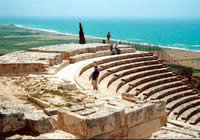|
|
| |
| |
| |
|
| |
 |
| |
|
| uses Google technology and indexes
only and selectively internet - libraries
having books with free public access |
|
 |
|
|
 |
|
| |
|
| |
Previous | |
Next |
|
 |
SIR SAMUEL WHITE BAKER
CYPRUS AS I SAW IT IN 1879
page 23 View PDF version of this page the adjacent country. A plain of most fertile soil extends along the sea-coast towards the east for six miles, and in breadth about four miles. The present town of Larnaca stands on the sea-board of this plain, which to the west of the port continues for about four miles, thus giving an area of some ten miles in length, forming almost a half circle of four miles in its semidiameter ; the whole is circumscribed by hills of low but increasing altitudes, all utterly barren. Through the plain are two unmistakable evidences of riveraction which at some remote period had washed down from the higher ground the fertile deposit which has formed the alluvium of the valley. Within this apparently level plain is a vestige of a once higher level, the borders of which have been denuded by the continual action of running water during the rushes from the mountains in the rainy season. This water action has long ceased to exist. There can be little doubt that in the ancient days of forest-covered mountains, the rainfall of Cyprus was far greater than at present, and that important torrents swept down from the hill-sides. W e see evidences of this in the rounded blocks, all water-worn, of syenite and gneiss, which are intermingled with the bits of broken pottery in the vale, alike relics of the past and proving the changes both in nature and in man since Cyprus was
in the zenith of prosperity.
A level plateau about eighteen feet above the lowest level of the plain shows the original surface. The soil of the entire valley is calcareous, and is eminently adapted for the cultivation of the vine and cereals. As the rain has percolated through the ground, it has become so thoroughly impregnated with sulphate of lime that it has deposited a series of strata some six
View PDF version of this page
|
 |
| |
Previous |
First |
Next |
|
|
|